Tag archives: astronomy
Feedback on a scheme to cloak Earth from hostile aliens
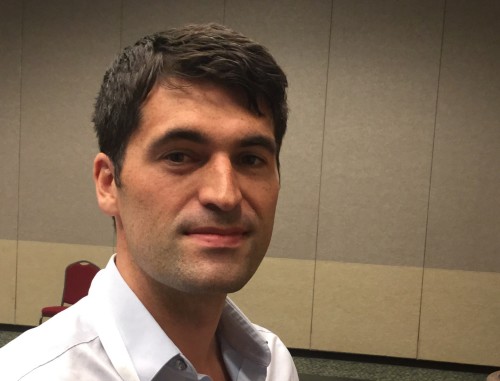
David Kipping doesn’t want to hide from aliens.
By Hamish Johnston at the APS April Meeting in Salt Lake City
Earlier today I caught up with David Kipping of Columbia University in the US after his fascinating talk about what could make an exoplanet habitable. I wanted to ask Kipping about a quirky paper that he and Alex Teachey published a few weeks ago, which I wrote about in the The Red Folder.
Kipping and Teachey described how a laser could be used to cloak the Earth from the prying eyes of an extraterrestrial civilization. The paper was published just before 1 April, so at the time I wasn’t sure whether the paper was legitimate (it is) and Kipping told me that publishing before April Fools’ Day did cause some confusion.
So what feedback has Kipping had about the paper?
Primates and paradoxical twins in the ISS, cosmic musicals, alien advertising and more
By Tushna Commissariat
The International Space Station (ISS) usually has only the human variety of primate on board, but earlier this week a gorilla seemed to have joined the crew. If you thought that this was part of one of the hundreds of planned experiments on the ISS you would be wrong. Instead, it was crew member Scott Kelly’s birthday hijinks after his twin brother sent him the suit for his birthday as the astronaut celebrated a year in space. Kelly will return to Earth in six days’ time.
Interestingly, this is the first time NASA has sent up one half of a pair of twins into space and is studying just how life on the ISS will change Scott’s physiology from that of his twin Mark. Apart from looking at how life in space will alter everything from Scott’s DNA to his gut microbes, this is also a real-life variation of the “twin paradox” experiment where Scott will return to the planet a bit “younger” than his twin in that Scott’s clock runs a bit slower than Mark’s, thanks to the ISS’s orbital speed of 17,000 mph. After reading this, if you feel like you would like a go on the ISS, NASA is currently hiring.
View all posts by this author | View this author's profile
A big Lidl telescope in Belfast
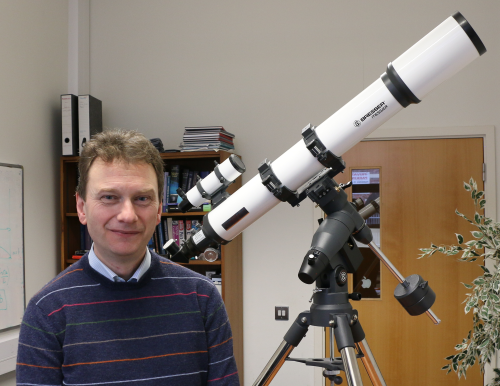
Not so Lidl: Alan Fitzsimmons and his bargain telescope.
By Hamish Johnston
There is an old joke in the UK about going to the discount supermarket Lidl for a pint of milk and coming home with a new set of power tools or ski-wear for the entire family. That’s because the retailer is famous for its seemingly random special offers. One week it could be car accessories and the following week the same shelves could be stocked with pyjamas or camping gear.
But Alan Fitzsimmons of Queen’s University Belfast deserves an award for best physics-related Lidl bargain with this huge telescope that he bought at the supermarket. It makes perfect sense to me – both Lidl and the telescope’s maker Bresser are German companies and, of course, Germany is famous for its optics.
View all posts by this author | View this author's profile
Earth-gazing, a very noteworthy astronomer, chilling with Einstein and more
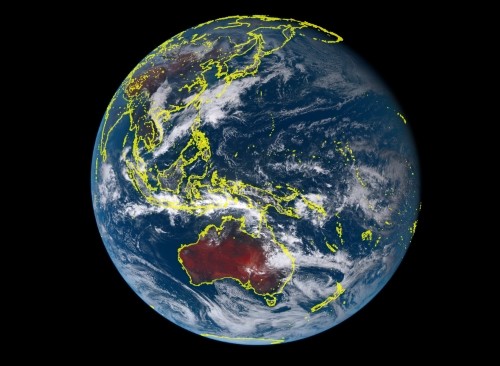
The Earth as seen by Himawari-8 earlier today. (Courtesy: JSA)
By Hamish Johnston
Who hasn’t wanted to float high above the Earth and gaze down on our planet as sunlight and clouds dapple across its surface. Thanks to the “Glittering Blue” animation, such views are not just for a privileged few astronauts. This stunning animation of one day’s observations from the Japanese weather satellite Himawari-8 has been put together by satellite-imagery analyst Charlie Lloyd. He has also included a nice FAQ page that explains some of the amazing phenomena captured by the satellite, including a huge tropical storm and the daily cloud cycles of a rainforest.
You can read more about Lloyd and the images in The Atlantic article “A New and Stunning Way to See the Whole Earth”. If you want to know what Himawari-8 is seeing right now, it has its own live webcam.
View all posts by this author | View this author's profile
Scientists battle celebrities, a quantum ‘unconference’ and space travel, past and future
By Tushna Commissariat
Its been a strange week for scientists and celebrities popping up together on the world stage – what with rapper B.o.B and Neil deGrasse Tyson’s very public face-off about the former’s conspiracy theory claims of the Earth being flat – but it didn’t end there. In a celebrity trio that is even more surprising, physicist Stephen Hawking has come together with Hollywood actor Paul Rudd, (most recently starring in the film Ant-Man) in a video narrated by Keanu Reeves. Earlier this week, Caltech’s Institute for Quantum Information and Matter hosted the event One Entangled Evening: a Celebration of Richard Feynman’s Legacy. As a promo of sorts for the event – which had special appearances by Rudd, Reeves, Hawking, Bill Gates and even Yuri Milner, apart from actual quantum physicists such as John Preskill and Dave Wineland – they filmed the above video with Rudd and Hawking battling each other at a game of quantum chess. You will have to watch the video to see who wins.
View all posts by this author | View this author's profile
Physicists’ pets, seven stars for Bowie, ping-pong in space and more
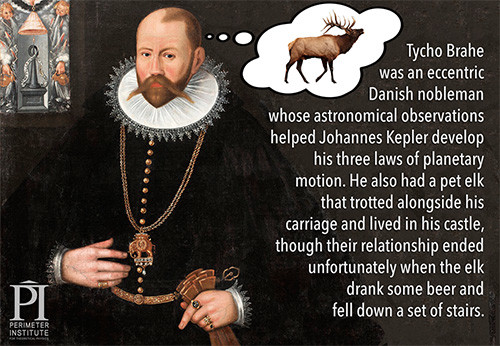
Prancer and the astronomer: Brahe and his pet elk. (Courtesy: Perimeter Institute)
By Tushna Commissariat
Sparks of inspiration come from many sources, but for some of the 20th century’s most well known scientists, their four-legged pets played a key role. From Tesla’s cat “Macak” – his interest in electricity was lit as a child when he noticed sparks generated while he stroked Macak – to Schrödinger’s (real live) dog “Burshie”, these intellectual giants sought the company of pets just as we do and over at the Perimeter Institute’s website, you can learn all about “Great physicists and the pets who inspired them”. My favourite “pet” is of course Tycho Brahe’s infamous elk (you can read about it in the image above). With all of these pets about, its a miracle that a paper wasn’t eaten by a naughty dog or cat!
Is the solar system’s planetary count back up to nine?
By Tushna Commissariat
In August 2006 the distant world that is Pluto was “downgraded” from planet to “dwarf planet” by the International Astronomical Union. Now, 10 years on, it seems that a new planet may be joining the ranks of the other more familiar eight, thanks to two researchers from the California Institute of Technology in the US, who have uncovered evidence of a giant planet tracing a bizarre, highly elongated orbit in the outer solar system.
Although it has not been observed directly just yet, Konstantin Batygin and Mike Brown discovered the planet’s existence via mathematical modelling and computer simulations. The newly found “Planet 9” is about 10 times as massive as Earth and its orbit is nearly 20 times farther from the Sun on average than Neptune, placing it firmly within the Kuiper belt. If the duo’s calculations are correct, it means that it takes Planet 9 anywhere between 10,000 and 20,000 years to complete one orbit, making it a long year indeed. The research is presented in The Astronomical Journal (which is published by IOP Publishing, which also publishes Physics World).
View all posts by this author | View this author's profile
Physics World 2015 Focus on Astronomy and Space is out now
By Louise Mayor
 Woolly hats are being donned and there’s a nip in the air as the longest night of the year in the Northern hemisphere approaches. All this darkness makes it the perfect season to gaze up at the stars, planets and puffy nebulae above. But binoculars and amateur telescopes can only enhance the view by so much. To really push the boundaries of how far and how fine we can see, we must turn to international telescope projects both on the ground and in space.
Woolly hats are being donned and there’s a nip in the air as the longest night of the year in the Northern hemisphere approaches. All this darkness makes it the perfect season to gaze up at the stars, planets and puffy nebulae above. But binoculars and amateur telescopes can only enhance the view by so much. To really push the boundaries of how far and how fine we can see, we must turn to international telescope projects both on the ground and in space.
To update you on what we think are the most exciting current and future projects we bring you the Physics World Focus on Astronomy and Space, which you can read free of charge in its entirety.
One particularly ambitious imaging effort is described in the article “Portrait of a black hole“, in which Physics World reporter Tushna Commissariat reports on how a group of astronomers plans to take the first-ever image of a black hole. Despite their name, black holes are apparently not black and the Event Horizon Telescope collaboration has already begun pointing a network of ground-based telescopes at its target: Sagittarius A*, the supermassive black hole at the centre of our galaxy.
View all posts by this author | View this author's profile
Radiation blasts render Earth’s twin inhospitable to life
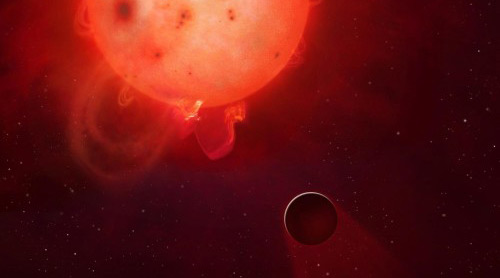
Radioactive? Kepler-438b is regularly irradiated by huge flares of radiation from its host star. (Courtesy: Mark A Garlick/University of Warwick)
By Tushna Commissariat
In the past decade or two, exoplanetary research has been booming as NASA’s Kepler telescope and its cohorts have found nearly 2000 exoplanets and 5000 promising candidates. Unsurprisingly, we have been searching long and hard for those planets that could be habitable or are as similar in shape, size and proximity to the host star as the Earth is to the Sun. Indeed, in January this year Kepler scientists announced that they had found the most Earth-like planet to date – Kepler-438b – orbiting within the habitable zone of its host star, the red dwarf Kepler-438, which lies about 470 light-years from Earth.
The planet, which is slightly bigger than our own, was found to be rocky, and, thanks to its location, rather temperate, meaning that it could have flowing water on it – two key factors that astronomers look for when accessing a planet’s habitability. Unfortunately, David Armstrong of the University of Warwick in the UK and colleagues have now found that Earth’s twin is regularly bathed in vast quantities of radiation from its star – a real dampener when it comes to the formation of life as we known it.
View all posts by this author | View this author's profile
X-ray visions of the past, undead physics, stargazing cruises and more
By Tushna Commissariat
Peering into a small 17th century metallic box, without damaging its contents, is no mean feat. But thanks to the use of synchrotron radiation, scientists at the European Synchrotron Radiation Facility (ESRF) in Grenoble were able to “see” inside one, using a technique known as synchrotron X-ray phase contrast micro-tomography. They were also able to create a 3D reconstruction of clay medals concealed within the very fragile and badly oxidized box, which was discovered on the archaeological site of the Saint-Laurent church, and is now at the archaeological museum of Grenoble (MAG). Take a look at the video above to see what the box held. You can also learn more about the researcher’s tomography technique in an article of ours.
Tomorrow is Halloween, so we hope you have your physics-themed pumpkins carved and out on your doorsteps. For some spooky reading this week, take a look at Davide Castelvecchi‘s “Zombie physics: 6 baffling results that just won’t die” story over on the Nature News website. In it, he lists six “undead” results – things that physicists just can’t seem to prove or disprove – including long-running disagreements over certain dark-matter results, hemispheric inconsistencies and spinning protons. Let us know what you think are some of the most undead physics results that should be laid to rest, in the comments below. And while you are at it, make sure to look at today’s creepy edition of Fermilab Today to read about the rise of the zombie accelerator and the “The cult of the Tev.”